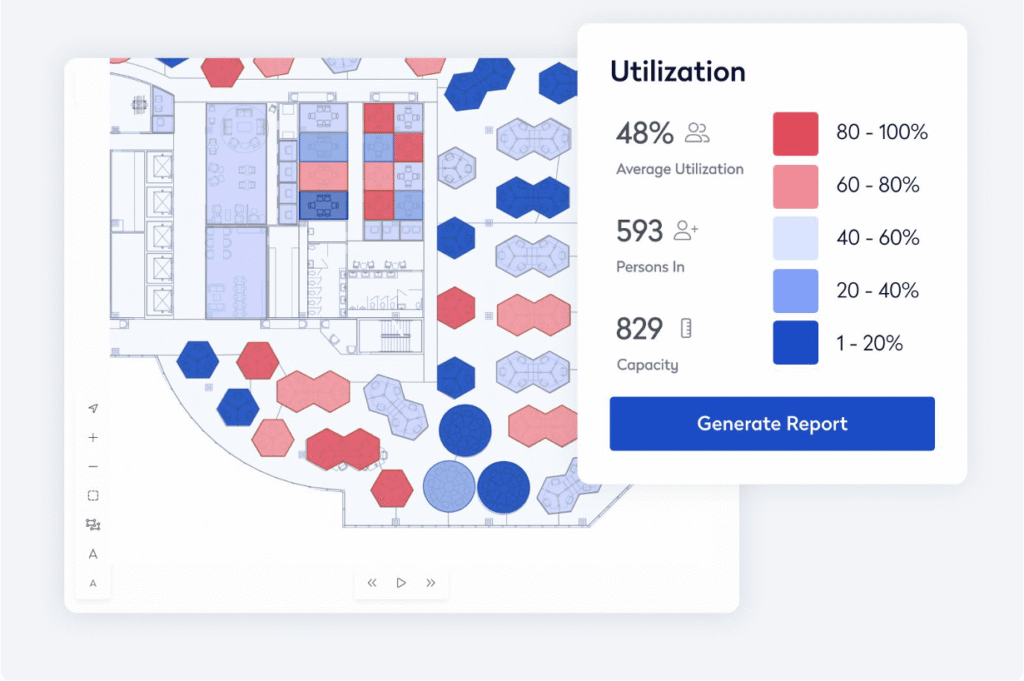Organisations today are awash with workplace data. Sensors count every movement, badge swipes track entries, Wi-Fi logs record connections, booking apps capture meeting room use, and surveys measure sentiment. Dashboards glow with heatmaps and utilisation graphs. Leaders are promised insights at the click of a button.
Yet despite this abundance of data, many companies are struggling to make better workplace decisions. Occupancy dashboards might show who is in the office, but they rarely explain why people choose to come in – or why they stay away. Sentiment surveys can flag dissatisfaction, but they often stop short of telling leaders what actions to take.
The result is a paradox: more data than ever before, but less clarity on what really matters. This is workplace data fatigue – and it is slowing down the very progress the data was supposed to accelerate.
The problem with counting
The rise of workplace data has its roots in efficiency. Companies wanted to know whether their expensive offices were being used to full potential. Occupancy sensors, booking systems, and utilisation reports seemed to provide the answer. And in some ways, they did. It became easier to see that certain floors were empty, certain rooms were overbooked, and certain days were busier than others.
But counting alone is not strategy. Knowing that 60% of desks are occupied on Tuesdays tells you very little about whether those desks are enabling performance, collaboration, or engagement. Counting misses the context. It measures activity, not value. And when companies optimise only for counts, they risk cutting space or redesigning layouts in ways that undermine experience and performance.
The overload of dashboards
Another issue is sheer volume. Workplace leaders are faced with an array of dashboards, each promising actionable insight. But the reality is often overwhelming. Metrics arrive from different systems, in different formats, with different definitions. Data is siloed, inconsistent, and hard to integrate. Leaders spend more time reconciling numbers than drawing conclusions.
This overload creates fatigue. Decision-makers tune out, dismissing the dashboards as noise. Valuable insights get buried under an avalanche of numbers. In the end, people fall back on intuition or anecdote – the very opposite of what data was meant to achieve.
What really needs measuring
The answer is not more data, but better data – data that illuminates the connection between workplace and performance. That means shifting focus from activity to outcomes. Instead of asking “How many people used the office today?”, organisations should be asking:
- Did employees feel more productive when they were in the office?
- Did collaboration increase as a result of time spent together?
- Did the workplace contribute to well-being, inclusion, and engagement?
- Did clients or projects benefit from improved knowledge-sharing?
These questions move beyond utilisation and into value creation. They reflect the true purpose of workplace strategy: to enable people and organisations to perform at their best.
Integrating qualitative and quantitative
One of the biggest gaps is the failure to integrate subjective and objective data. Quantitative metrics – occupancy, bookings, space ratios – are useful, but they must be complemented by qualitative insights from employees. Engagement surveys, focus groups, and interviews reveal the “why” behind the numbers.
When used together, these two perspectives create a fuller picture. For example, occupancy data may show that people avoid a particular floor. Survey feedback might reveal that the lighting is poor or the layout discourages collaboration. Data without context leads to misinterpretation; data with context drives action.
From fatigue to focus
Overcoming workplace data fatigue requires a reset in how organisations approach measurement. Leaders must move from indiscriminate collection to purposeful curation. Three shifts can help:
- Clarity over curiosity – Gather data with a clear purpose. Don’t measure everything simply because you can.
- Integration over isolation – Combine different data sources into a coherent story. Stop treating surveys, sensors, and systems as separate.
- Outcomes over outputs – Focus on the link between workplace and business performance, not just activity levels.
When these shifts happen, workplace data becomes energising instead of exhausting. Leaders see not just what is happening, but why – and more importantly, what to do about it.
Towards a more intelligent workplace strategy
The workplace of the future will be defined by intelligence, not just information. Intelligence comes from filtering noise, connecting dots, and translating data into decisions. It means aligning workplace metrics with broader organisational goals – growth, innovation, sustainability, talent retention.
Data will always have a role, but its value lies not in volume, but in meaning. Organisations that move beyond counting and start measuring what truly matters will unlock a more strategic, human-centred approach to the workplace. Those that don’t will remain stuck in dashboards, fatigued by numbers that never translate into action.
The opportunity is clear: less measuring, more meaning. Because in the end, it’s not how much data you have – it’s how well you use it.




